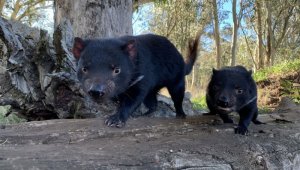Tish
SF VIP
- Location
- Rural N.S.W. Australia
Restoring devils to mainland ecosystems could also help other threatened species.
The pitter-patter of Tasmanian devil feet was heard in the wild of mainland Australia for the first time in 3,000 years, after a group of devils was released in Barrington Tops, a protected national park about 120 miles (200 kilometers) north of Sydney.
Tasmanian devils (Sarcophilus harrisii), the world's largest carnivorous marsupial, have been long gone from most of the Australian continent, and until now the only remaining wild populations were on the island of Tasmania. Mainland devils were likely outcompeted by dingos, the wild dogs that were introduced to Australia at least 3,500 years ago, and which are now considered a pest species.
However, a decade of dingo eradication has offered Tasmanian devils a second chance. By clearing out dingos and reintroducing devils to Barrington Tops, conservationists hope to not only reestablish thriving wild populations of the iconic marsupials, but to also help protect other native species that are threatened by invasive predators, according to a statement released on Oct. 5 by Global Wildlife Conservation (GWC).
Aussie Ark, a wildlife nonprofit in Australia, has been breeding and studying Tasmanian devils for more than a decade, with the goal of eventually reintroducing devils into the wild once conditions were sustainable for their survival, according to the statement. For the recent release, Aussie Ark partnered with GWC and WildArk, another wildlife conservation nonprofit; they released 11 Tasmanian devils on Sept. 10.
Tasmanian devils are black-furred and stocky with blunt muzzles and short limbs, measuring about 22 to 26 inches (55 to 65 centimeters) long and standing about 12 inches (30 cm) high at the shoulder, according to the Australian Museum. Devils on the island of Tasmania were safe from dingos, which never got a foothold there. But Tasmania's devils face another deadly threat: a highly contagious and fatal cancer known as devil facial tumor disease (DFTD). First detected in the 1990s, the cancer has since wiped out about 90% of Tasmania's devils, leaving only 25,000 in the wild, according to the GWC statement.
Conservation experts in Tasmania work to isolate healthy devils from sick ones, and to breed healthy populations. But there are limited opportunities on the island for reintroducing the healthy devils and keeping them separated from infected devils, "and it's impossible as yet to eradicate the disease," GWC president Don Church told Live Science.
Because the cancer only spreads through direct facial contact between devils — usually when they nip each other's faces while competing over prey — a cancer-free devil population on Australia's mainland would therefore be safe from infection.

The pitter-patter of Tasmanian devil feet was heard in the wild of mainland Australia for the first time in 3,000 years, after a group of devils was released in Barrington Tops, a protected national park about 120 miles (200 kilometers) north of Sydney.
Tasmanian devils (Sarcophilus harrisii), the world's largest carnivorous marsupial, have been long gone from most of the Australian continent, and until now the only remaining wild populations were on the island of Tasmania. Mainland devils were likely outcompeted by dingos, the wild dogs that were introduced to Australia at least 3,500 years ago, and which are now considered a pest species.
However, a decade of dingo eradication has offered Tasmanian devils a second chance. By clearing out dingos and reintroducing devils to Barrington Tops, conservationists hope to not only reestablish thriving wild populations of the iconic marsupials, but to also help protect other native species that are threatened by invasive predators, according to a statement released on Oct. 5 by Global Wildlife Conservation (GWC).
Aussie Ark, a wildlife nonprofit in Australia, has been breeding and studying Tasmanian devils for more than a decade, with the goal of eventually reintroducing devils into the wild once conditions were sustainable for their survival, according to the statement. For the recent release, Aussie Ark partnered with GWC and WildArk, another wildlife conservation nonprofit; they released 11 Tasmanian devils on Sept. 10.
Tasmanian devils are black-furred and stocky with blunt muzzles and short limbs, measuring about 22 to 26 inches (55 to 65 centimeters) long and standing about 12 inches (30 cm) high at the shoulder, according to the Australian Museum. Devils on the island of Tasmania were safe from dingos, which never got a foothold there. But Tasmania's devils face another deadly threat: a highly contagious and fatal cancer known as devil facial tumor disease (DFTD). First detected in the 1990s, the cancer has since wiped out about 90% of Tasmania's devils, leaving only 25,000 in the wild, according to the GWC statement.
Conservation experts in Tasmania work to isolate healthy devils from sick ones, and to breed healthy populations. But there are limited opportunities on the island for reintroducing the healthy devils and keeping them separated from infected devils, "and it's impossible as yet to eradicate the disease," GWC president Don Church told Live Science.
Because the cancer only spreads through direct facial contact between devils — usually when they nip each other's faces while competing over prey — a cancer-free devil population on Australia's mainland would therefore be safe from infection.


